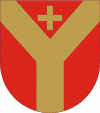Ylöjärvi
 |
Ylöjärvi is mostly a rural town. It does not have a clear center; the Tampere–Vaasa highway (E12) and the Tampere–Seinäjoki railway divide the municipality's town center into two major distinct parts: the church village and Soppeenmäki. The railway, completed in 1971, has no passenger seats in the Ylöjärvi area, so buses handle all public transport. The population has increased rapidly in recent years. In 1990 it was slightly over 18,000, while on December 31, 2011 it was 30,942.
The neighbouring municipalities are Hämeenkyrö, Ikaalinen, Kihniö, Nokia, Parkano, Ruovesi, Tampere and Virrat. The municipality of Viljakkala was consolidated with Ylöjärvi on January 1, 2007. The municipality of Kuru was consolidated with Ylöjärvi on January 1, 2009. The coat of arms of Ylöjärvi was designed by Gustaf von Numers and it was confirmed in 1954.
Results of the 2021 Finnish municipal elections, resulted in the True Finns being the largest group on Ylöjärvi council, in Ylöjärvi.
The chapel parish of Ylöjärvi was founded in 1779 by separating it from Pirkkala. The first church in Ylöjärvi, located on the site of the current church, was completed in 1781, but was destroyed in a fire caused by lightning in 1842. Ylöjärvi was founded as a municipality in 1869. Since January 1, 2004, it has been known as a town (kaupunki). The Finnish Museum of Refrigeration also locates at Ylöjärvi.
Map - Ylöjärvi
Map
Country - Finland
 |
 |
| Flag of Finland | |
Finland was first inhabited around 9000 BC after the Last Glacial Period. The Stone Age introduced several different ceramic styles and cultures. The Bronze Age and Iron Age were characterized by contacts with other cultures in Fennoscandia and the Baltic region. From the late 13th century, Finland became a part of Sweden as a consequence of the Northern Crusades. In 1809, as a result of the Finnish War, Finland became part of the Russian Empire as the autonomous Grand Duchy of Finland, during which Finnish art flourished and the idea of independence began to take hold. In 1906, Finland became the first European state to grant universal suffrage, and the first in the world to give all adult citizens the right to run for public office. After the 1917 Russian Revolution, Finland declared independence from Russia. In 1918, the fledgling state was divided by the Finnish Civil War. During World War II, Finland fought the Soviet Union in the Winter War and the Continuation War, and Nazi Germany in the Lapland War. It subsequently lost parts of its territory, but maintained its independence.
Currency / Language
| ISO | Currency | Symbol | Significant figures |
|---|---|---|---|
| EUR | Euro | € | 2 |
| ISO | Language |
|---|---|
| FI | Finnish language |
| SV | Swedish language |















